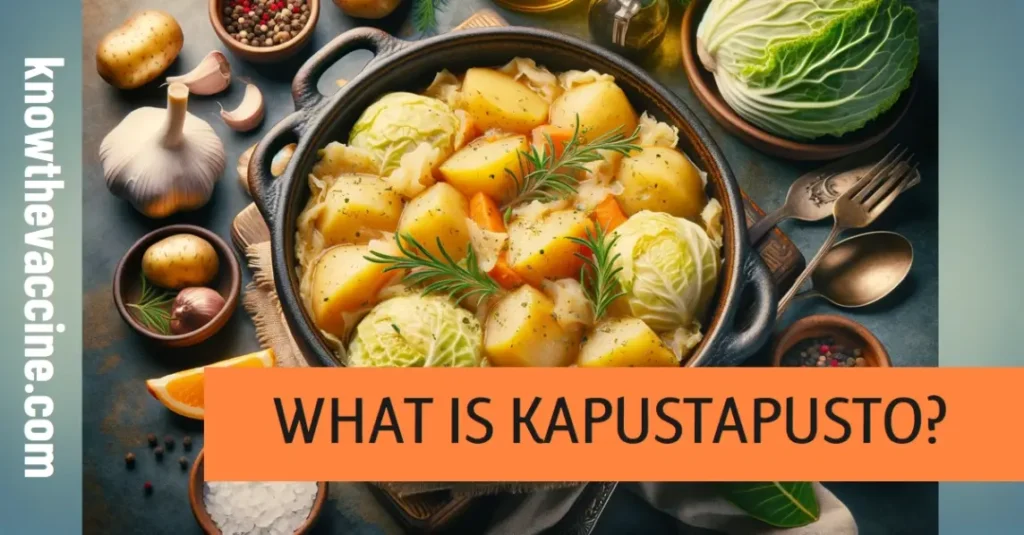
Kapustapusto is a beloved traditional Polish dish made from cabbage, potatoes, and other nutritious ingredients. This satisfying one-pot meal is rich in flavor, nutrients, and history. Read on to learn all about kapustapusto and why you should add it to your regular recipe rotation.
Key Takeaways
- Kapustapusto is a Polish dish of braised cabbage, potatoes, and often meat or sausage.
- It originated as a hearty winter meal for peasants and farmers in Poland.
- The dish is nutrient-dense, and high in fiber, antioxidants, vitamins, and minerals.
- Kapustapus has a lovely combination of sweet, sour, creamy, and hearty flavors.
- It can be made vegetarian or vegan by omitting the meat and using plant-based cream.
- It is a comforting, budget-friendly, and healthy one-pot recipe perfect for family dinners.
What is Kapustapusto?
Kapustapusto is a classic Polish dish made with shredded cabbage, diced potatoes, and sautéed onions. It has its roots in traditional Eastern European peasant cuisine but remains a beloved staple and comfort food in Polish homes today. The name “Kapustapusto” literally translates to “cabbage stew” in Polish.

Origins and History
Kapustapusto’s origins can be traced back hundreds of years to a time when Eastern European families relied on inexpensive, nourishing ingredients that were easy to grow or forage. Kapustapusto has its roots in Polish peasant cuisine. The word “kapusta” means cabbage in Polish, while “pusto” translates to plain or simple.
This dish likely originated as a hearty winter meal for farmers and peasants who needed nourishing food to get through cold months when fresh produce was scarce. Cabbage was one of the few crops that could be stored through winter.
Potatoes were another important staple ingredient, along with cured meats like kielbasa sausage. The ingredients were inexpensive, readily available, and could create a filling meal.
Over time, it became a beloved tradition across Polish households. It remains a specialty in modern Polish cooking, often served on Christmas Eve or other holidays.
Ingredients in Traditional Kapustapusto
Kapustapusto has a short list of simple ingredients that meld together into comforting flavors. Here’s what you’ll typically find in this dish:
- Cabbage: The star ingredient! Kapusta means cabbage in Polish. A head of green or white cabbage is braised down to softness.
- Potatoes: Peeled and diced potatoes add heartiness. Starch from the spuds helps thicken the braising liquid.
- Onion: Sliced onions add savory depth and sweetness when cooked down.
- Meat or Sausage: Traditional kapustapusto contains smoked kielbasa or other cured sausage. It can also be made with diced ham, chicken, turkey, or beef.
- Tomato Paste or Sauce: Tomato product gives the dish richness and balance the sweet cabbage.
- Vegetables: Carrots are commonly added for sweetness. It can also include mushrooms, peas, corn, bell peppers, or other veggies.
- Herbs and Spices: Bay leaves, marjoram, caraway seeds, black pepper, and parsley season the ingredients.
- Stock or Broth: Meat or vegetable stock builds flavor as the dish braises. Chicken or beef broth works well.
- Dairy: Heavy cream or sour cream gives kapustapusto a lovely tangy creaminess.
What Makes Kapustapusto So Tasty?
Part of what makes kapustapusto such a legendary dish is the complex and satisfying blend of flavors. Here are some of the taste elements that come together in perfect harmony:
- Sweetness: Braised cabbage becomes mellow, sweet, and almost nutty. Onions and carrots also contribute to natural sugars.
- Sour: Tomato products and creamy dairy offer a pleasant sour tang. This brightens the other flavors.
- Savory: Smoked meats, herbs, spices, and cooking down the vegetables creates deep, meaty savoriness.
- Creamy: The cream or sour cream provides a cool, rich creaminess to balance the heartier flavors.
- Hearty: Tender potato and meat give the dish filling substance.
Kapustapusto beautifully combines all these taste sensations into one pot. The result is a comforting, complex, and crave-worthy meal.
Why is Kapustapusto Good for You?
Beyond being tasty comfort food, it is actually quite nutritious. Here are some of the health benefits this dish can provide:
- High Nutrient Density, Low Calories: Kapustapusto packs a nutritional punch despite being relatively low in calories. A one-cup serving of the dish contains only around 50-60 calories but delivers vitamins, minerals, and fiber. The key vegetable ingredients – cabbage, potatoes, and onions – are all high in essential nutrients like vitamin C, vitamin K, manganese, and potassium.
- Heart-Healthy: The fiber, vitamins, and plant compounds help support heart health in a few key ways. The high fiber and potassium content supports healthy blood pressure levels while antioxidants like vitamin C and flavonoids may aid blood vessel and cholesterol health. A few regular servings a week can be part of an overall heart-healthy eating pattern.
- May aid Weight Management: With filling fiber and protein but few calories, kapustapusto makes a satisfying meal that can help maintain a healthy weight or support weight loss goals. The high water content of the cabbage and vegetables also gives it a low energy density, meaning it’s very filling relative to its calorie count.
- Antioxidant Properties: Compounds in the vegetables help combat free radicals and inflammation.
- Lean Protein: Meat or plant-based protein make it a complete, nutrient-dense meal.
- Budget-Friendly: Cabbage, potatoes, and carrots are inexpensive. It stretches them into a hearty dinner.
As you can see, humble kapustapusto is far from a boring side. It’s actually an excellent source of vitamins, antioxidants, fiber, and lean protein in one satisfying dish.
Kapustapusto Recipe and Cooking Tips
If you want to make authentic kapustapusto at home, follow these helpful cooking tips:
- Choose the Right Cabbage: Green or white cabbage works well. For a delicate flavor, opt for Savoy cabbage.
- Cut the Cabbage Into Chunks: Cut the cabbage into 2-3 inch wide wedges first, then chop into chunks. This makes it easier to cook evenly.
- Massage the Cabbage First: Before cooking, sprinkle the cabbage chunks with salt. Massage and scrunch the salt into the leaves using your hands. This helps soften the texture.
- Brown the Meat and Vegetables: For deeper flavor, brown the onions, carrots, potatoes, and meat before simmering.
- Simmer Low and Slow: Cook the kapustapusto at a bare simmer. The longer cooking time allows flavors to meld.
- Stir Occasionally: Periodically stir the pot to prevent sticking and distribute the flavor.
- Adjust Seasoning: Taste and add more salt, pepper, herbs, or spices if desired near the end.
- Finish with Dairy: Stir in cream or sour cream at the very end to finish. Serve warm.
Step-by-Step Kapustapusto Recipe
Follow this simple step-by-step method for making perfect kapustapusto at home.
Ingredients You will Need:
- 1 medium-head green cabbage
- 1lb baby Yukon gold potatoes
- 1 onion
- 3 carrots
- 1 lb kielbasa or ham
- 3 cloves garlic
- 2 tbsp olive oil
- 28oz can crush tomatoes
- Chicken or vegetable broth
- 1 bay leaf
- Salt, pepper, and caraway seeds to taste
- 1⁄4 cup heavy cream or sour cream
Instructions:
- Chop the cabbage into chunks, about 2-3 inches wide. Generously sprinkle salt over the pieces. Use your hands to massage the salt into the cabbage until it starts releasing liquid. This will take 5-10 minutes. Rinse the cabbage and set aside.
- Peel and dice the potatoes. Peel and slice the carrots and onion. Mince the garlic.
- In a large pot or Dutch oven, heat the olive oil over medium-high heat. Brown the onion and carrots for 3-4 minutes. Then add the potatoes and kielbasa. Cook for 5 more minutes, stirring occasionally.
- Add the garlic and cook another minute until fragrant.
- Pour in the crushed tomatoes and broth until the vegetables are nearly submerged. About 4 cups of broth should suffice.
- Add the bay leaf, salt, pepper, and caraway seeds. Bring the liquid to a simmer.
- Add the cabbage chunks and stir to combine. Place a lid on top, leaving it slightly ajar.
- Reduce heat to low and gently simmer for 1 hour. Periodically check that nothing is sticking to the bottom and give the pot a stir. Add a splash more broth if needed.
- After an hour, taste and adjust the seasoning as desired. Discard the bay leaf.
- Stir in the heavy cream or sour cream until warmed through.
- Serve kapustapusto warm in bowls with crusty bread. Garnish with fresh parsley. Enjoy this tasty Polish specialty!
Leftovers will keep for 4-5 days refrigerated. The flavors improve as it sits. Reheat gently before serving again.
Nutritional Information for 1 Cup Serving:
- Calories: 60
- Fat: 1g
- Carbs: 12g
- Fiber: 4g
- Protein: 2g

Frequently Asked Questions – FAQs
Traditionally kapustapusto is meatless, but you’re welcome to add cooked and diced chicken, turkey, or pork if desired. Just stir it in during the last few minutes of simmering.
Yes! Simply omit the meat and use vegetable broth. Substitute coconut cream for the dairy.
Green, white, or Savoy all work wonderfully. Red cabbage has a more assertive flavor.
No, the long braising time sufficiently cooks the potatoes. Cubing small 1 inch pieces helps them cook evenly.
It’s better to chop fresh cabbage, since pre-shredded starts releasing liquid immediately instead of braising down.
Stored in an airtight container, kapustapusto will keep for 4-5 days in the fridge. Flavors continue improving.
Certainly! Allow it to cool fully then transfer to freezer bags or containers. Thaw in the fridge before reheating gently.
You can make it vegetarian with beans, lentils, or chickpeas instead of meat. Extra vegetables also bulk it up.
Conclusion
In conclusion, kapustapusto is a nutritious, economical, and deeply satisfying Polish dish with origins in thrifty peasant cooking. Give it a try for an easy weeknight meal packed with flavor and health benefits. Between the simple ingredients, short cook time, and versatility. It’s no wonder this humble cabbage stew remains a beloved classic both in Poland and beyond. With its comforting yet light qualities, kapustapusto makes for the perfect any-time-of-year meal to enjoy alone or share with loved ones.






